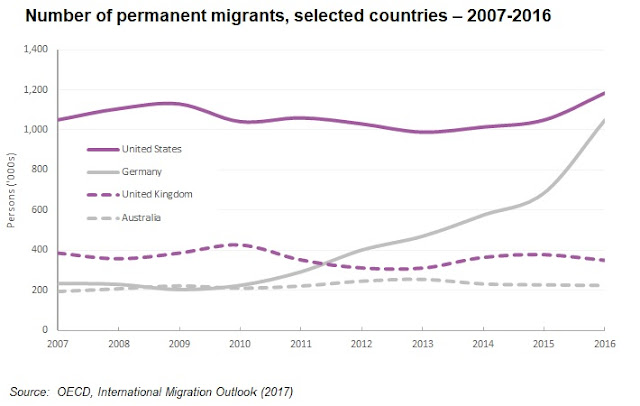There's little doubt that Australia's population growth is a hot topic in the media. The latest data indicates an annual population growth rate of 1.6%, with around 62% of population growth attributable to net overseas migration. In 2017, Australia's net migration intake was 240,300. But how does this compare internationally? The recent release of the International Migration Outlook by the OECD provides an opportunity to examine the most recent data for the 35 member countries.
Permanent inflows of migrants
Australia recorded an inflow of 223,000 permanent migrants in 2016, ranking sixth in the OECD. However, this is far behind the leading countries. The United States (USA) and Germany both recorded over 1 million permanent migrants in 2016. Coming in a distance third was the United Kingdom with 350,000.
These countries have far larger populations and economies than Australia, so while it's useful to see the ranking in terms of volume, a better comparison is the share of population that these inflows comprise. These 223,000 permanent migrants comprised 0.9% of the Australian population in 2016, the same rate recorded by Belgium and Ireland.
There were eight countries where the proportion was more than 1% of the population. Tiny Luxembourg's 20,000 permanent migrants comprised 3.4% of its population and this was followed by Switzerland (1.5%) and Sweden (1.4%). The United States may rank highest in terms of volume, but the permanent migrant inflow was just 0.4% of the population.
The table below shows the number of permanent migrants for selected countries over the period 2007-2016.
The large increase in permanent migration to Germany is the salient feature. From 2007-2011, the intake was less than 300,000 per annum, but from 2012 the number rose rapidly as the Syrian refugee crisis took hold. The increase was particularly rapid between 2015 (intake of 686,000) and 2016, when permanent migration numbered more than 1 million. The 2016 figure was more that triple that of 2011.
Permanent migration to the USA has been steadily increasing since 2013, however this was a year when the intake was relatively low at 990,000. The 2016 figure of 1.18 million was the highest recorded since 2009 when there were 1.13 million permanent migrants moving to the USA.
Australia's permanent migration intake over this period was relatively steady, which is in contrast to the ABS data. It should be noted that the data presented by the OECD is different to the ABS figures for net overseas migration. This is due to potential differences in the definitions of migration and the standardisation procedures employed when working with statistical data from several countries. According to the OECD, Australia's permanent migration reached a peak of 254,000 in 2013.
Asylum seekers
More recent data is available for asylum seekers. In 2017, Australia took 35,170 asylum seekers, ranking eighth in volume, but comprising just 0.14% of the population. Once again, the USA and Germany head the list in terms of volume, taking 329,800 and 198,260 persons respectively. Italy and Turkey also took more than 100,000 asylum seekers in 2017. The OECD notes that many Syrians currently in Turkey are not defined in a statistical sense as asylum seekers as they have temporary protection status, so the actual number may be higher.
Unfortunately the 2017 data does not indicate the origin of asylum seekers. However historic data on the OECD website does. In 2016, the most common countries of origin of people seeking asylum in Australia were Malaysia, Iran and Sri Lanka. Unsurprisingly, Syrian asylum seekers topped the list in several European countries, whereas the main source countries in the USA were El Salvador, Mexico (itself an OECD country) and Guatemala.
Asylum seekers comprise a very small percentage of a country's population and the OECD data confirms this. In 2017, Greece headed the list - the 57,000 asylum seekers comprising 0.5% of the population. This was followed by Luxembourg (0.4%) and Iceland (0.3%). Australia's 0.14% ranks it with France and Canada, just outside the top ten.
Summary
OECD figures show that Australia's permanent migration intake was 223,000 in 2016, the sixth largest of the OECD countries. However the intake is dwarfed by that of the USA and Germany - both of these countries received more than 1 million permanent migrants in 2016. Permanent migration to Australia comprised 0.9% of the population in 2016. Between 2007 and 2016 permanent migration was relatively steady in the USA, UK and Australia, but increased sharply in Germany after 2011. Australia took more than 35,170 asylum seekers in 2017, comprising 0.14% of the population.


No comments:
Post a Comment